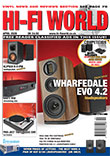Power |
|
How much power do you need to reproduce a Nine Inch Nails concert LOUD, from their 24/96 Blu-ray? WHAT IT TELLS US AV receivers commonly produce 100 Watts per channel into 8 Ohms and around 160 Watts into 4 Ohms. As most receivers now have seven channels and seven power amplifiers on-board as a result, and as most loudspeakers are 4 Ohms, this adds up to a grand total of 1120 Watts. Onkyo’s TX-NR906 we measured as producing 2kW! Whilst power supply sag would reduce this if delivered all in one go, it’s still the case that AV receivers are power houses. Since a two channel system goes loud enough in a medium sized room, using 40 W per channel into a modern loudspeaker of 87dB sensitivity, the 100 W per channel or more delivered by today’s receivers is enough even for Terminator movies played very loud in a large, dedicated home cinema room. For home hi-fi use, playing high quality music, it is more than enough, even with Rock concerts in 24/96 from some of the heavier bands like Nine Inch Nails. In practice it is usually the front three channels that carry music, the rears often reproducing soft ambient effects such as audience noise, applause etc. Where a source places full level music in all channels seven loudspeakers, producing 90dB total in a room, each produce 82dB, so an AV receiver puts less power into loudspeakers to achieve a high volume (a stereo system puts 87dB into each loudspeaker for 90dB total).
Onkyo's TX-NR906 produces 290 Watts per channel into 4 Ohms, our tests show. With seven channels, that's 2kW total. There is a trade off between power and quality in the confined space of a receiver. For best sound quality it is common to run an amplifier in Class A/B mode. This requires the use of what is called ‘standing’ or ‘quiescent’ current, current that flows all the time through the output transistors, producing heat and consuming power, whether music is played or not. Over seven channels this produces a lot of heat that exits top vents. Although pure Class B working gives good measured performance and runs cooler it usually does not sound so good, possibly because of short term internal junction heating effects. Running transistors hot makes them thermally more stable. So an AV receiver that runs hot isn’t ‘bad’ from the sound quality point of view, nor is it especially wasteful because A/B mode will consume in the order of 1 Watt extra per channel approximately, or 7 Watts in all. Class D digital amplifiers would appear to be a solution but unreliability has deterred widespread use.
HOW WE MEASURE IT Output power is measured with the receiver connected to custom built, high power resistors that act as loads. We have two load sets, one heat sink mounted and fan cooled, one open air convection cooled using high working temperature resistors. Both use one 200W, 8 Ohm resistor on each channel to present an 8 Ohm load and two in parallel to present a 4 Ohm load, doubling the thermal capacity. Although the load resistors are large, mounted on heat sinks and have fan cooling, in practice receivers do not have the thermal capacity to be run at full power into them for much more than a minute or so, and this would not be a realistic representation of real life usage. Our loads have a high power rating only to ensure there is sufficient capacity to handle 500 and 1000 Watt amplifiers.
Resistive loads for power measurement use four 8 Ohm, 200 Watt resistors. The load resistors are custom built to our specification. They use zero hysteresis (iron free) wire to avoid high frequency distortion from magnetic effects. This ensures our high frequency (10kHz) distortion measurements are representative of the amplifier under test, and are not influenced by the load.
No test equipment earth connections are made to the loads; they are fully balanced. Balanced input test equipment is connected directly, unbalanced through an balanced-to-unbalanced buffer. This is especially important with balanced bridge amplifiers, and digital amplifiers running a large d.c. output offset.
Balanced to unbalanced buffer amplifier. We use the most commonly adopted and broadly understood measurement of power, output of a sine wave at 1kHz into 8 Ohm load and 4 Ohm loads. The voltage into each is measured and the power calculated.
The voltage limit is that just before ‘visual clip’ on an oscilloscope (around 1% max). Full power measurement is made quickly, within 15 seconds or so, to avoid overheating. Power is measured by a Rohde & Schwarz UPL and HP8903B test set, both of which have strengths in this test
All modern receivers use solid-state (bipolar transistors, FETs, etc) and feedback to set bandwidth, linearity etc. Most clip (overload) symmetrically and suddenly, so their overload point is precise. |












